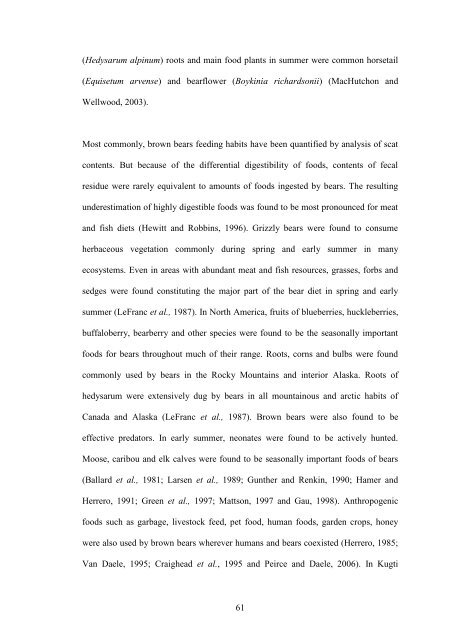Certificate - Etheses - Saurashtra University
Certificate - Etheses - Saurashtra University
Certificate - Etheses - Saurashtra University
You also want an ePaper? Increase the reach of your titles
YUMPU automatically turns print PDFs into web optimized ePapers that Google loves.
(Hedysarum alpinum) roots and main food plants in summer were common horsetail<br />
(Equisetum arvense) and bearflower (Boykinia richardsonii) (MacHutchon and<br />
Wellwood, 2003).<br />
Most commonly, brown bears feeding habits have been quantified by analysis of scat<br />
contents. But because of the differential digestibility of foods, contents of fecal<br />
residue were rarely equivalent to amounts of foods ingested by bears. The resulting<br />
underestimation of highly digestible foods was found to be most pronounced for meat<br />
and fish diets (Hewitt and Robbins, 1996). Grizzly bears were found to consume<br />
herbaceous vegetation commonly during spring and early summer in many<br />
ecosystems. Even in areas with abundant meat and fish resources, grasses, forbs and<br />
sedges were found constituting the major part of the bear diet in spring and early<br />
summer (LeFranc et al., 1987). In North America, fruits of blueberries, huckleberries,<br />
buffaloberry, bearberry and other species were found to be the seasonally important<br />
foods for bears throughout much of their range. Roots, corns and bulbs were found<br />
commonly used by bears in the Rocky Mountains and interior Alaska. Roots of<br />
hedysarum were extensively dug by bears in all mountainous and arctic habits of<br />
Canada and Alaska (LeFranc et al., 1987). Brown bears were also found to be<br />
effective predators. In early summer, neonates were found to be actively hunted.<br />
Moose, caribou and elk calves were found to be seasonally important foods of bears<br />
(Ballard et al., 1981; Larsen et al., 1989; Gunther and Renkin, 1990; Hamer and<br />
Herrero, 1991; Green et al., 1997; Mattson, 1997 and Gau, 1998). Anthropogenic<br />
foods such as garbage, livestock feed, pet food, human foods, garden crops, honey<br />
were also used by brown bears wherever humans and bears coexisted (Herrero, 1985;<br />
Van Daele, 1995; Craighead et al., 1995 and Peirce and Daele, 2006). In Kugti<br />
61

















